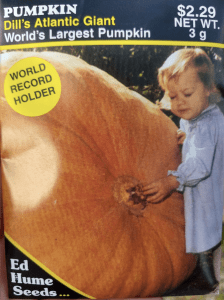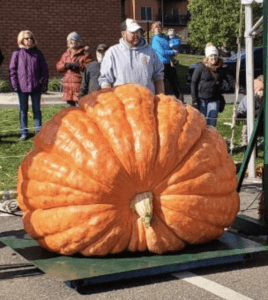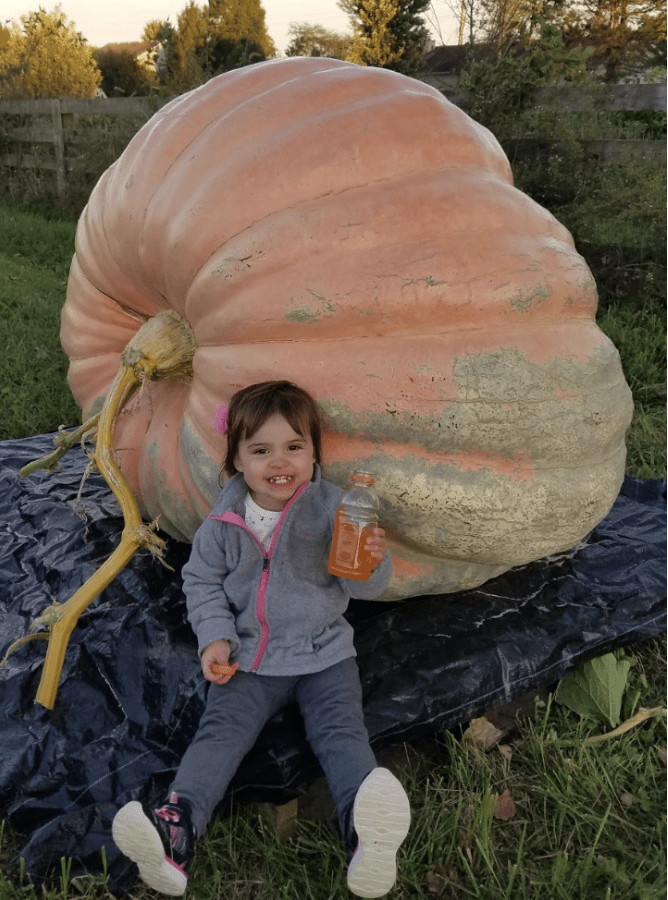Pumpkins are no small fruit in American history and culture. In the United States, pumpkins adorn our porches during Halloween and fill our horns of plenty at Thanksgiving. Their seeds make a delicious fall snack. People use them as boats to paddle long distances just because they can smashing world records or beating each other out in “pumpkin regattas”. This is not unlike Massachusetts man Todd Sandstrum’s use of his 1,200 pound pumpkin to paddle 8 miles down the Taunton river in 2016. Certain squash sadists drop theirs from cranes raised 100 feet in the air. Those lucky enough to have grown up near county and state fairs may remember walking through an old barn scattered with hay to behold that giant, sagging, orange behemoth that won the prize that year for biggest pumpkin. Some grow them to compete, some to sell, but farmers who grow the most massive pumpkin do so to see the wonder on people’s faces when they get to see a fruit pushed to its limits.
Pumpkins originate in South America, where they were used as eating vessels. Pumpkins didn’t used to grow quite that large in ancient South America, and looked quite different than the orange, mostly round pumpkins we see outside of our grocery stores in the fall. In Mexico, yellowish-white, warty pumpkins about the size of the headless-horseman’s lost head are cooked into a sweet treat called calabazas en tacha (candied pumpkin) for their Dia de Los Muertos celebrations. There are 42 types of pumpkins, according to Toot Sweet 4 Two, including your run-of-the-mill Jack O’ Lantern pumpkins. Wee-Be-Littles are small, bright orange, and almost perfectly round, usually with large stems, Fairy Tale pumpkins look like someone’s sat on them, and Casper pumpkins are named because they, well, they’re white like Casper.
But where in the world did we get such massive pumpkins?
Well, basically, from one guy named Howard.
 Howard Dill was a Canadian family pumpkin farmer who, in 1986, won the record for biggest pumpkin in the world for a pumpkin whose seeds he’d later patent as “Atlantic Giants”. Nearly every award winning pumpkin can trace its roots directly back to that one. After a certain weight, the pumpkin can’t support its own mass, so Atlantic Giants are usually sloped, rather than round. They can be deep orange or pale orange with thick, but not hard walls, so that it can keep from caving in but still grow, according to this Smithsonian article.
Howard Dill was a Canadian family pumpkin farmer who, in 1986, won the record for biggest pumpkin in the world for a pumpkin whose seeds he’d later patent as “Atlantic Giants”. Nearly every award winning pumpkin can trace its roots directly back to that one. After a certain weight, the pumpkin can’t support its own mass, so Atlantic Giants are usually sloped, rather than round. They can be deep orange or pale orange with thick, but not hard walls, so that it can keep from caving in but still grow, according to this Smithsonian article.
Joe Ailits, a Minnesota field agronomist with the Pioneer seed company, has grown pumpkins since his youth. He uses Atlantic Giant pumpkin seeds with some selective breeding for color and symmetry. Ailits’ squash, he said in a phone interview, have “exceptionally dark orange color, large size, and perfectly symmetrical shape.”
 What, and who, makes an award-winning pumpkin? They’re mostly awarded based on weight, and they’re mostly grown by Americans, though many of the record breakers live outside of the United States. The biggest pumpkin in the world to date, weighing in at over a ton, was grown in a professional greenhouse in Belgium, and Dill himself lived in Canada.
What, and who, makes an award-winning pumpkin? They’re mostly awarded based on weight, and they’re mostly grown by Americans, though many of the record breakers live outside of the United States. The biggest pumpkin in the world to date, weighing in at over a ton, was grown in a professional greenhouse in Belgium, and Dill himself lived in Canada.
Other than the need to have something bigger and, well, bigger than everyone else, there may be another reason so many in this country have taken up this unique sport. It could be what Dustin Trychta, and many other veteran competitors, lovingly refer to as “the pumpkin belt,” a region in Eastern North America including of West Virginia (where Trychta grows his hulking gourds), New York, Pennsylvania, Wisconsin, and the northernmost third of Ohio. This is where pumpkin growing is the best. Ailits said so many of these regions are right around the 45th parallel, that sweet spot between the equator and the North Pole, where the days are long enough for pumpkins to get adequate sunlight and consistently warm enough that their skin remains flexible without hardening. Ailits said, “The Goldilocks proverbial perfect porridge lies on the 45th parallel”.
For gargantuan growers who live outside of the pumpkin belt, the season starts early. The normal transplant time for Halloween pumpkins in the Northern part of the United States is late May and can go into July for the South, according to the University of Illinois. Trychta said that, although West Virginia’s last frost isn’t usually until early May, he typically plants his seeds on April 20th, and they’re in the ground two or so weeks later. From there, it’s a race against the clock (and the weather) for the perfect pumpkin. Humidity has to be carefully checked so that the leaves can photosynthesize comfortably without the fruit rotting. Temperature is also crucial; too hot or too cold and the growing slows, and too sunny and the shell becomes solid, staying any further growth and rendering a would-be Goliath a wee David.
Luck, said Reeb, is the most important part. No matter how carefully farmers hand-pollinate, geo modify for the best genetic features, or curate their soil, Mother Nature ultimately chooses how big a pumpkin will grow. A sudden storm or an unattended varmint problem can ruin months of hard work.
The best part, though, is when people get to see them. “I just want to make people smile,” Ailits said. “For me, the only time a pumpkin has value is after it’s harvested.” Trychta has used his giants in a “guess the weight” contest to fund wishes from the Make a Wish foundation. Reeb, too, loves seeing kids marvel at behemoth pumpkins. His own two children, he said, love to help him farm and watch the pumpkins swell to the tops of their heads. “They always hate to see them go,” he said.

Reeb’s daughter posing with his pumpkin from 2018. Credit: Brian Reeb
Reeb and Trychta both love sharing their fruit with the world. Reeb sells many of his pumpkins to a local pumpkin carver, and Trychta donates his to local elementary schools so that the next generation can scavenge about in their orange guts and try their hands at growing their own giants. These ideas are fairly tame compared to what other competitors do. A common trend for many communities is to hold “pumpkin regattas,” where pumpkins are hollowed out and canoed in for prizes or clout. Trychta held the first West Virginia University pumpkin regatta in 2017. Some more thrill-seeking farmers haul their fruit to “pumpkin-chunkin’” contests, where gourds are launched out of an air cannon, or catapult to see how far they’ll fly. The original contest made its last rounds in the summer of 2017, before closing after woman filed a lawsuit claiming to be injured by an air cannon in the year before, but the tradition still lives on in local communities. The pumpkins too heavy to be launched are lifted up with a crane and smashed on the ground, where kids can scavenge for seeds. Ailits gets rid of his 1,200 pound beauties this way and sells others to be used in displays at the Mall of America and the Minnesota Zoo.
 Across the board, the resounding answer to the question “why pumpkins?” has been, “because we love pumpkins.” The thriving community of competitive growers support and uplift each other, giving each other, as well as novice or hobbyist growers, a nearly never-ending stream of advice. Their community blog, bigpumpkins.com, has hundreds of pages of friendly debates, growing tips, and pictures of members with their award-winning pumpkins. So many are only too happy and excited to talk about what they love to do, and share the literal fruits of their labor with the world. Growing the world’s biggest pumpkins takes the patience, care, and wisdom of a sage, and these champs do it every year.
Across the board, the resounding answer to the question “why pumpkins?” has been, “because we love pumpkins.” The thriving community of competitive growers support and uplift each other, giving each other, as well as novice or hobbyist growers, a nearly never-ending stream of advice. Their community blog, bigpumpkins.com, has hundreds of pages of friendly debates, growing tips, and pictures of members with their award-winning pumpkins. So many are only too happy and excited to talk about what they love to do, and share the literal fruits of their labor with the world. Growing the world’s biggest pumpkins takes the patience, care, and wisdom of a sage, and these champs do it every year.

